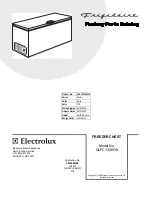
6.
CARE AND CLEANING
WARNING!
Refer to Safety chapters.
6.1
General warnings
CAUTION!
Unplug the appliance before
carrying out any
maintenance operation.
This appliance contains
hydrocarbons in its cooling
unit; maintenance and
recharging must therefore
only be carried out by
authorized technicians.
The accessories and parts of
the appliance are not
suitable for washing in a
dishwasher.
6.2
Periodic cleaning
CAUTION!
Do not pull, move or
damage any pipes and/or
cables inside the cabinet.
CAUTION!
Take care of not to damage
the cooling system.
CAUTION!
When moving the cabinet,
lift it by the front edge to
avoid scratching the floor.
The equipment has to be cleaned
regularly:
1.
Clean the inside and accessories with
lukewarm water and some neutral
soap.
2.
Regularly check the door seals and
wipe clean to ensure they are clean
and free from debris.
3.
Rinse and dry thoroughly.
4.
If accessible, clean the condenser
and the compressor at the back of
the appliance with a brush.
This operation will improve the
performance of the appliance and
save electricity consumption.
6.3
Defrosting of the
refrigerator
Frost is automatically eliminated from the
evaporator of the refrigerator
compartment every time the motor
compressor stops, during normal use.
The defrost water drains out through a
trough into a special container at the
back of the appliance, over the motor
compressor, where it evaporates.
It is important to periodically clean the
defrost water drain hole in the middle of
the refrigerator compartment channel to
prevent the water overflowing and
dripping onto the food inside.
6.4
Defrosting the freezer
CAUTION!
Never use sharp metal tools
to scrape off frost from the
evaporator as you could
damage it. Do not use a
mechanical device or any
artificial means to speed up
the thawing process other
than those recommended by
the manufacturer. A
temperature rise of the
frozen food packs, during
defrosting, may shorten their
safe storage life.
www.aeg.com
24
Summary of Contents for SDB41611AS
Page 63: ...DEUTSCH 63 ...
















































